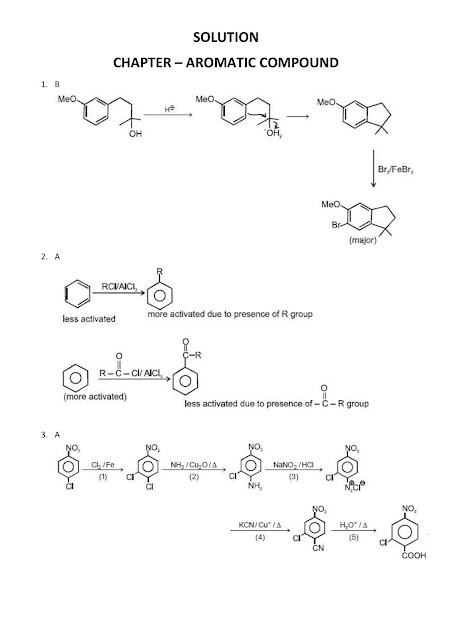JEE
Organic Chemistry Topicwise Questions
Aromatic Compounds Questions for Practice
with Solutions
What are Aromatic Compounds?
Aromatic compounds are chemical compounds that consist of conjugated planar ring systems accompanied by delocalized pi-electron clouds in place of individual alternating double and single bonds.
They are also called aromatics or arenes. The best examples are toluene and benzene. Aromatics require satisfying Huckel’s rule. Plants and micro-organisms have an exclusive route to benzene-ring compounds. The great majority of aromatic compounds in nature, therefore, are produced by plants and micro-organisms, and animals are dependant upon plants for many aromatic compounds either directly or indirectly.
Aromatic Compounds Examples
Aromatic hydrocarbons, are hydrocarbons containing sigma bonds and delocalized pi electrons between carbon atoms in a ring. For example, benzene. They are known as aromatic due to their pleasant smell.
Aromatic compounds are broadly divided into two categories: benzenoids (one containing benzene ring) and non-benzenoids (those not containing a benzene ring) for example, furan. Any hydrocarbon can be classified as an aromatic compound provided they follow the Huckel rule. According to the Huckel rule, for a ring to be aromatic it should have the following properties:
- Planarity
- Complete delocalization of the π electrons in the ring
- Presence of (4n + 2) π electrons in the ring where n is an integer (n = 0, 1, 2, . . .)
Huckel’s Rule of Aromaticity
Huckel’s rule states that only planar, fully conjugated monocyclic polyenes having 4n + 2 π electrons, where n is an integer, that is, n = 0, 1, 2, 3, 4, etc., should possess aromatic stability. An aromatic compound must be planar and contain a cyclic cloud of π electrons below and above the plane of the molecule. It contains SP2 hybridized carbon atoms and must obey the Huckel rule.
According to this rule, the ring system must have (4n+2) π electrons, where n is any whole number (0, 1, 2, 3, etc). On this basis the ring systems which have 2(n=0), 6(n=1), 10(n=2), 14(n=3) etc pi electrons are aromatic. Typical examples of aromatic compounds are benzene, naphthalene, and anthracene.
Properties of Aromatic Compounds
Arenes are mostly nonpolar and non-miscible in water. These compounds are usually unreactive and are used as solvents for various other nonpolar compounds. Their carbon to hydrogen ratio is high therefore, they are characterized by sooty yellow flame.
Classification of Aromatic Compounds
The classification of arenes is based on the position of the functional group. They are classified into two and we have discussed below:
1. Nuclear Substituted Compounds
In any aromatic compound whenever any substituent or functional group, is directly linked to the benzene ring, it is known as a nuclear-substituted compound.
2. Sidechain Substituted Compounds
In any aromatic compound if the functional group is available in the side chain of the ring then it is known as a side chain substituted compound. These compounds are named as the phenyl derivatives of the relative aliphatic compounds.
QUESTIONS👇
Do share it with your friends.


































No comments